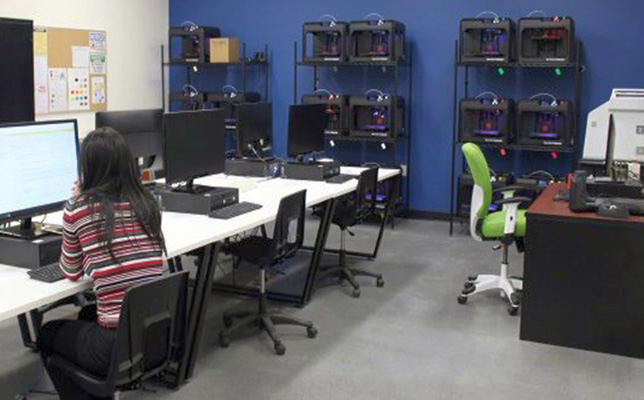NJ High School Opens 3D Printing Innovation Center
- By Dian Schaffhauser
- 12/05/16
A New Jersey school system has added a 3D design and printing center to its public high school to join other tech education initiatives in the district, including a state-of-the-art audio production studio, a drone flying club and the use of robots to help students learn programming. Mt. Olive School District in Flanders, NJ opened the new design lab in Mt. Olive High School as an instructional space to give engineering and industrial design students the ability to plan, prototype and produce products.

The MakerBot Innovation Center at Mt. Olive High School is designed to provide students with a learning environment that replicates what industry is like. Images: MakerBot.
The center includes 30 new MakerBot 3D printers, making it the first MakerBot center in a high school, according to the company. This is a dramatic expansion of equipment in the facility. In 2013, a local foundation had donated a MakerBot Replicator 2X to the school, and last year the school acquired a couple of additional 3D printers for its STEM lab. Similar centers have opened up in colleges and universities, including the University of Maryland and Penn State.
"Our goal with the MakerBot Innovation Center is to provide students a learning environment that replicates what industry is like," said Design Teacher Megan Boyd in a MakerBot article about the project. "We've been talking to many leaders at the college and industry level to better understand what skills students will need to succeed. We heard over and over again that in our rapidly evolving economy, skills like problem-solving and collaboration will be much more important for students than purely technical skills. The MakerBot Innovation Center will help us teach these skills, as it offers a very different, more hands-on learning environment that gives students more freedom to experiment, learn from failure and progress their thinking."
The same space also holds a "ThinkerSpace" and workshop area. The former is a meeting place where students can come together to discuss projects; the latter has workbenches and tools for prototyping.
Access to 33 printers will allow "entire" classes to load and run their print jobs simultaneously, noted Boyd, speeding up how the feedback process for students.
"When you can quickly make changes and evolve your idea, it's easier to take criticism from others," said David Bodmer, a robotics teacher at Mt. Olive High School. "We consider that part of the core skill set that students need to succeed. Students need to learn to be flexible in their thinking and be receptive to feedback to refine and develop their ideas."
The curriculum for both the engineering and design students leads them through the basics of design and print preparation. But they come at it from different viewpoints, added Bodmer. "While our engineering courses are focused on the more technical aspects of prototyping, such as assembly design, our industrial design classes very much focus on product design, aesthetics and user experience. Combining the arts with more traditional STEM learning is really where the magic happens."
As an example, Bodmer said, a recent set of lessons had students study the various historic stages of industrial design and then design and print a chess set inspired by a particular style.
Next year the instructors plan to introduce a capstone course to push students to apply their skills to solve real-world challenges. The school expects to collaborate with local companies and nonprofits on various projects.
"That's where we ultimately want to be," explained Boyd. "Students first learn basic skills that then enable them to pursue areas or projects they are passionate about. We will give them as much freedom as we can. It's very well possible that some of them will even start their own Kickstarter campaigns in the future."
"We don't know what these students will end up doing when they enter the job market," added Bodmer. "But these are the type of skills that will benefit them in any career path."
The new center was funded by the local board of education and a grant from the United States Department of Defense. MakerBot worked with the school in setting up the center and training school staff.
About the Author
Dian Schaffhauser is a former senior contributing editor for 1105 Media's education publications THE Journal, Campus Technology and Spaces4Learning.